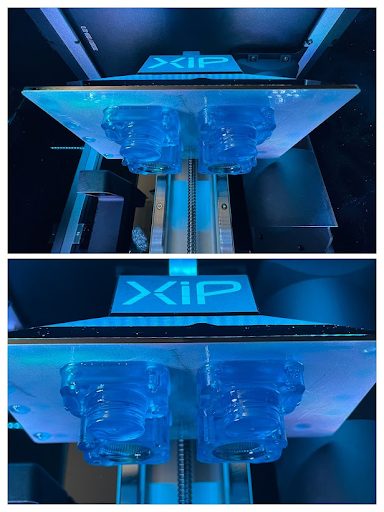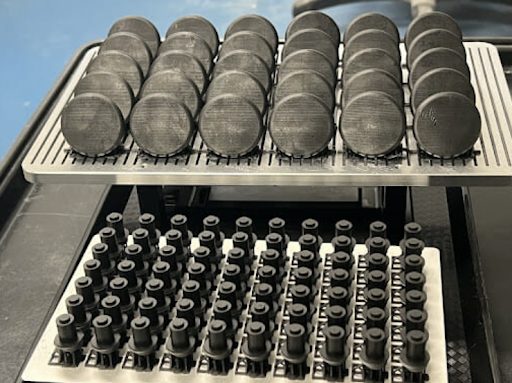- Metal 3D Printing Guide: What It Is & How It Works [2024] - February 5, 2024
- Metal Injection Molding: What It Is & Top Alternatives [2024] - January 11, 2024
- 11 Fastest 3D Printers on the Market (Industrial and Desktop) [2023] - December 11, 2023
3D printed tools have become a popular and growing trend in the industry, especially in mechanics and transportation fields. From custom-tailored levers to torque wrenches and sockets, 3D printing technology has opened a world of possibilities that have disrupted traditional manufacturing methods.
While some 3D printing processes replace conventional manufacturing, 3D printed tooling can enhance traditional manufacturing processes. “Tools” in this context can be thought of as any part used within the manufacturing process, ranging from a woodworking clamp to a 3D printed mold used to create a custom end product.
So if you’re looking for ways to make manufacturing faster, more efficient, or more precise – 3D printing tools could be the answer you need.
3D Printed Tools vs 3D Printed Tooling
3D printed tools refer to the production of handheld or power tools using 3D printing technology. These tools can be used for various applications such as cutting, drilling, and shaping materials. They are typically made from strong and durable materials like nylon, ABS, or polycarbonate.
3D printed tools are designed to be lightweight and ergonomic, making them easier to handle and operate. They can be produced quickly and cost-effectively, and they can be customized to meet specific design requirements. However, 3D printed tools may not be suitable for heavy-duty or high-volume manufacturing applications.
3D printed tooling refers to the production of molds, jigs, fixtures, and other products using 3D printing technology. These products are used in manufacturing processes to help with the production of end-use parts. 3D printed tooling can be done with a range of materials, including metals, plastics, and composites.
3D printed tooling offers several advantages over traditional manufacturing, including reduced lead times, lowered costs, and increased design flexibility. 3D printed tooling also allows for the production of parts with complex geometries and internal cavities that are difficult or impossible to create using conventional manufacturing methods.
3D Printed Tool Examples

- Screwdrivers: Screwdrivers can be 3D printed in different shapes and sizes for various projects. They can be made of metal, plastic, or a combination of both materials.
- Wrenches and sockets: Wrenches and sockets can also be 3D printed in custom sizes and shapes with lightweight materials that are easier to use and transport.
- Contour guides: Contour guides help with modeling or measuring intricate features or shapes.
- Drill guides: This 3D printing tool allows manufacturers to drill holes accurately at various angles and different sizes.
3D Printed Tooling Examples
While 3D printed tools can be helpful for smaller projects and hobbyists, 3D printed tooling is increasingly important in industrial manufacturing processes.
1. 3D Printed Molds

3D printing technology is the perfect solution for creating complex geometries at scale. Builders can design and print custom molding tools for various materials quickly.
For instance, Alstom, one of the largest railway-manufacturing companies, leverages 3D printed tooling to to machine a new tool and molding for replacement parts. For the fastest results for their customers, Alstom began using the NXE 400Pro D printer. Alstom saw cost reductions, over five times production speed improvements, and higher-quality functional parts with high mechanical properties.
Another example of 3D printed molds is PepsiCo, which utilizes Nexa3D’s NXE 400 and xPEEK147 material as an enabler in various aspects of bottle development. PepsiCo was able to slash prototype tooling costs from $10,000 to $350 per mold set, create durable tooling that can produce more than 10,000 bottles per mold, compress prototype tooling development time from 4 weeks to 48 hours, and quickly produce highly detailed molds that are strong enough for industrial-level production runs.
2. Jigs and Fixtures

Jigs and fixtures are devices that hold and guide tools and workpieces during a manufacturing or assembly process. 3D printing makes it easy to create custom jigs and fixtures for specific tasks, helping to ensure accuracy and consistency.
Applied Rapid Technologies (ART) is one of the companies benefitting from 3D technology to print jigs and fixtures. With the NXE 400Pro, ART now prints over 25 pieces of mold parts, jigs, and fixtures in an hour or two. This allows the company to deliver mold and jig parts on-demand and with superior quality in a fraction of the time it would take to produce them using traditional methods.
3. Clamps, Grippers, and Brackets
Clamps are for holding objects in place during manufacturing processes. They can be customized to fit specific shapes and withstand various levels of pressure. Clamps are used to hold objects in place while they are being printed. Clamps can also be used to secure workpieces in place while machining or drilling, as well as for holding parts together during welding or brazing. Another application of clamps in manufacturing is for clamping jigs and fixtures to ensure accuracy when cutting or forming components.
Grippers help to move the object around during the printing process. For example, Thyssenkrupp Bilstein, a suspension supplier for the automotive industry, integrated collaborative robots or “cobots” that use 3D-printed grippers to reduce replacement costs. The company also uses 3D printed brackets and towers to support sensors during production, as well as 3D cuffs to hold cables in their correct positions.
Benefits of Using 3D Printed Tools
Whether you’re 3D printing a tool to use for an at-home project or are using 3D printing tooling for large-scale manufacturing, 3D printing functional tools offers several advantages over traditional production processes.
Instead of having to constantly make replacement machine-tooled parts, 3D printing allows for a quicker, more affordable way to produce new parts at scale.
Plus, with the wide range of materials available for 3D printing, manufacturers can make parts with different mechanical properties than metal that allow for greater flexibility and design complexity.
3D printing also allows for rapid prototyping, or the creation of preliminary 3D models or parts that can be used to evaluate a product’s functionality or design. It reduces the time needed to go from concept to physical product, allowing engineers and designers to test and improve different parts of their manufacturing process without having to machine-tool every change.
The Bottom Line on 3D Printed Tools & Tooling
With 3D printed tooling, manufacturers can transform production processes and create custom components quickly, cheaply, and accurately – without sacrificing performance or quality. This makes it possible for customers and hobbyists to get essential parts when needed.
But in order to gain the benefits of affordable, fast, and accurate 3D printing, engineers and manufacturers need the best 3D printers on the market.
Nexa3D industrial and desktop 3D printers create high-quality parts with superior accuracy and resolution. The Nexa3D XiP 3D printer offers the highest precision, speed, and the easiest setup and maintenance for professionals right at their desktop. The industrial Nexa3D NXE printer series provides high speeds and accuracy but with a larger build volume and 4K LCD screen for incredible detail, accuracy, and resolution.
By leveraging Nexa3D’s 3D printing technology, organizations can save time and money while producing durable and dependable parts and tools for all applications.
Ready to experience the power of 3D printed tooling?
